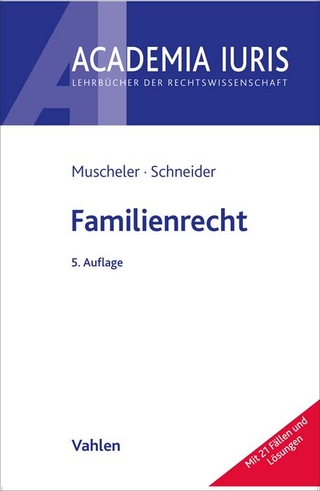
Family Justice
Hart Publishing (Verlag)
978-1-84946-501-4 (ISBN)
The first four chapters are historical and comparative, examining assumptions about family justice and offering a defence of the role of legal rights in family life, and the importance of good policy-making balancing outcome- and behaviour-focused approaches to family justice. Comparative examples from the US and Australia show how new approaches to family justice can be successfully deployed. The next three chapters are empirical, including a typology of the roles played and tasks addressed by the judges, overturning the commonly held assumption that the central judicial role is adjudication, emphasising the extent to which judges integrate outcome- and behaviour-focused approaches to family justice, and giving a detailed account of the daily work of circuit and district judges and legal advisers.
The conclusion is that there is a trend across jurisdictions, driven by technological innovation and by economic constraints, to reduce the role of courts and lawyers in favour of individual choices based on private or government-funded information sources. While these developments can be beneficial, they also have dangers and limitations. The final chapter argues that despite the move to privatised forms of dispute resolution, family justice still demands a sound judicial structure.
Mavis Maclean, CBE is co-founder of the Oxford Centre for Family Law and Policy, Oxford University and a Senior Research Fellow of St Hilda's College. John Eekelaar, FBA is Emeritus Fellow of Pembroke College, Oxford.
1. The Family Justice System
I Introduction
II Assumptions and Misperceptions
III What Is the Family Justice System?
IV Family Matters and Legal Rights
V An Historical Perspective
2. Family Justice: Outcome-focused and Behaviour-focused Approaches
I Impartiality, Processes and Outcomes
II A Third Approach: Abstention
III Child-centred Cases
IV The Intervention Options Reconsidered: the Nature of Relevant State Institutions
V Organisation of What Follows
3. Lawyers and Mediators: Towards Greater Collaboration?
I Family Law Practice
II Development of Mediation
III Criticisms of Mediation
IV Problems with Research Evidence
V Collaboration and Co-operation
VI New Initiatives
4. Courts: Changing Structures and Functions
I The Magistracy
II The Ecclesiastical and Divorce Courts
III The Demise of Reconciliation
IV Therapeutic Courts
V The Contemporary Structure and Functions of Family Courts
VI Court Support Services
VII The Recommendations of the Family Justice Review
5. Judging
I The Framework of the Family Courts in England and Wales
II The Empirical Evidence: Judges at Work
6. Family Courts in Action
I Roles Played, the Nature of the Court and the Nature of the Matter
II Time Spent According to Matters Dealt With
III The Daily Work of Family Law Judges in the Lower Courts
IV Reflections
7. Public Law Children Cases
I The Development of Child Protection in England and Wales
II The Children Act 1989 and its Aftermath
III Attempts to Control the Management of Child Protection Cases in the Family Justice System
IV Tensions and Contradictions in Child Protection Case Management
V The Benefits of Reasoned Judgments
VI Reflections
8. Private Law Disputes Involving Children
I Children's Welfare and Justice to Parents
II Custody Dispositions by Courts prior to the Children Act 1989
III The Children Act 1989
IV Contact between Parents and Children after Separation
V Legislative Responses
VI Justice and Decisions Involving Children
9. Late Modern Justice: Information, Advice and Privatisation
I Background
II Child Support: from Compulsion to Informed Support
III Financial Matters: Towards Informed Settlement?
IV Information, Advice and Justice
V Information, Rules and Discretion
VI Privatised Justice
VII Final Reflections
| Erscheint lt. Verlag | 3.6.2013 |
|---|---|
| Verlagsort | Oxford |
| Sprache | englisch |
| Maße | 156 x 234 mm |
| Gewicht | 534 g |
| Themenwelt | Recht / Steuern ► EU / Internationales Recht |
| Recht / Steuern ► Privatrecht / Bürgerliches Recht ► Familienrecht | |
| ISBN-10 | 1-84946-501-0 / 1849465010 |
| ISBN-13 | 978-1-84946-501-4 / 9781849465014 |
| Zustand | Neuware |
| Haben Sie eine Frage zum Produkt? |
aus dem Bereich


